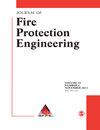Effects of humidity, temperature and slow oxidation reactions on the occurrence of gasoline-air explosions
引用次数: 17
Abstract
In order to investigate the effects of the humidity, temperature and slow oxidation reactions on the occurrence of explosions in gasoline-air mixtures, experiments are carried out in a cylindrical tunnel with a solid heating device. Experimental results show that whether a gasoline-air explosion occurs or not is determined by a critical relative humidity when the temperature of the heat source is maintained at a specific value. Under the experimental conditions in this study, when the heat source temperature is maintained at 550℃, the critical value of relative humidity is 32.3% ± 0.2%, and when the heat source temperature is maintained at 570℃, the critical value of relative humidity climbs to 37.7% ± 0.2%. The occurrence of gasoline-air explosions is very sensitive to the gas mixture temperature. It is shown that an explosion will not occur if the gas mixture temperature is lower than the critical value of 26℃. Influenced by slow oxidation reactions, concentrations of reactants can decrease below the explosion limit range, resulting sometimes in no observed occurrence of gasoline-air explosions. Experiments show, in this case, that the critical heat source temperature for the gas mixture explosion, defined by a probability of explosion occurrence of 20%, climbs from 510 to 550℃, i.e. it increases 40℃ solely due to the influence of slow oxidation reactions. Language: en湿度、温度和缓慢氧化反应对汽油-空气爆炸发生的影响
为了研究湿度、温度和缓慢氧化反应对汽油-空气混合物中爆炸发生的影响,在装有固体加热装置的圆柱形隧道中进行了实验。实验结果表明,当热源温度保持在一定值时,汽油-空气是否发生爆炸是由临界相对湿度决定的。本研究实验条件下,当热源温度保持在550℃时,相对湿度临界值为32.3%±0.2%,当热源温度保持在570℃时,相对湿度临界值攀升至37.7%±0.2%。汽油-空气爆炸的发生对混合气温度非常敏感。结果表明,当混合气体温度低于26℃的临界值时,不会发生爆炸。受缓慢氧化反应的影响,反应物的浓度可能降低到爆炸极限范围以下,导致有时没有观察到汽油-空气爆炸的发生。实验表明,在这种情况下,混合气爆炸的临界热源温度(爆炸发生概率为20%)从510℃上升到550℃,即仅由于缓慢氧化反应的影响,其临界热源温度升高了40℃。语言:在
本文章由计算机程序翻译,如有差异,请以英文原文为准。
求助全文
约1分钟内获得全文
求助全文

 求助内容:
求助内容: 应助结果提醒方式:
应助结果提醒方式:


